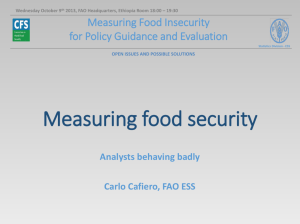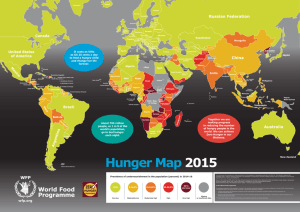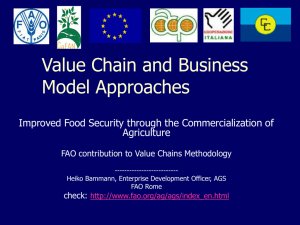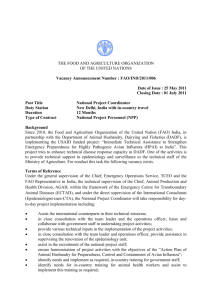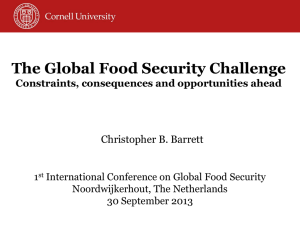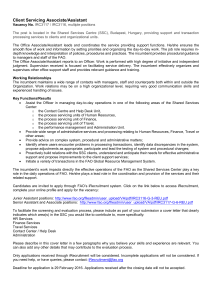Strategic Objective 4 Enable more inclusive and efficient food and
advertisement
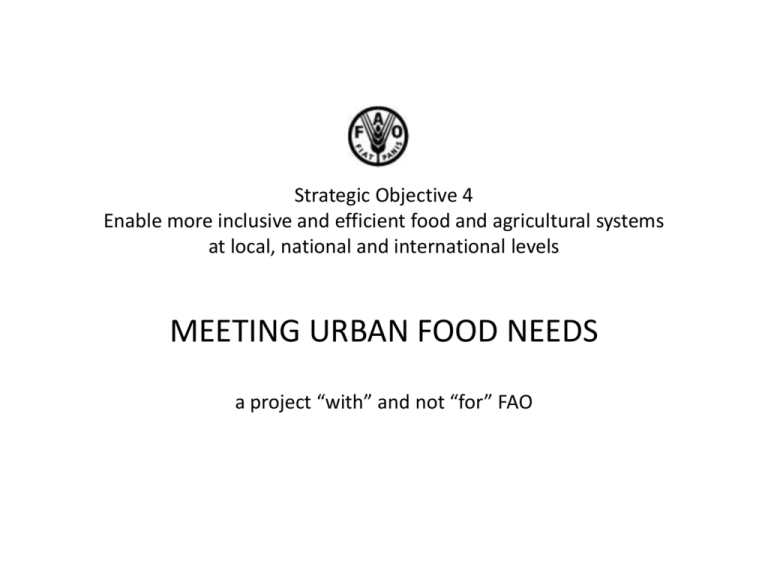
Strategic Objective 4 Enable more inclusive and efficient food and agricultural systems at local, national and international levels MEETING URBAN FOOD NEEDS a project “with” and not “for” FAO Olivio Argenti Coordinator Project “Meeting urban food needs” B613 – AGS FAO - Rome – Italy E: MUFN@fao.org Skype: FAO-MUFN STATIC COMMERCIAL FOOD SYSTEM WHY THIS PROJECT • Urban areas are constantly growing and diversifying, so is demand for food products and food-related services. • Numbers of households living close to – or below – poverty levels are growing. They need to access affordable, healthy and nutritious food. • Lack of appropriate and technically sound “local” policies, strategies and action/investment plans to: – stimulate private investments for increasing the efficiency and dynamism of (in)formal food-related operations (production, transport, packaging, processing, distribution, ...); – reduce costs/prices of food products and services, diversify their variety and improve their quality and safety; – improve the adequacy of “public” infrastructure, facilities and services, also through public-private partnerships and PPPs; – strengthen the inclusiveness, sustainability and resilience of food systems operations. FOR WHOM All these tasks fall mostly upon local government authorities at municipal, provincial and departmental/regional levels in developing countries and countries in transition whose responsibilities in these fields have been rapidly growing during the last decade. KEY QUESTIONS • • • • • • • • • • • • • • • • What are the fresh and processed food products consumed in my city and where do they originate from? How are urban families– and those living close to, or below, the poverty line - accessing food? At what cost? What food products are accessible to them and what are their conditions? What proportion of urban families spend most of their available income on food and are therefore very likely to suffer from price volatility? Is their number going to increase in the next ten year? What can be done to improve their access to safe and nutritious food? How is the urban food demand expected to increase in the following 10-15 years, how will its structure change and what are the major implications of such increase? How is the performance of the food system excluding groups of urban consumers? How can urban dynamics, socio-economic forces, services and facilities impact on food access and nutritional status of urban dwellers (e.g.: food deserts)? What are the current main sources of inefficiency within the system which increase costs - and thus the prices paid by urban consumers - and decrease revenues to producers? What food-related services are being requested within the urban space? How can informal food sector activities be supported so as to maintain their contribution to the local economy while reducing problems and risks caused to society? How can the negative impact of food systems activities on the environment and natural resources be reduced? What role can technology and technological, developments play in improving the efficiency, dynamism, inclusiveness and sustainability of food systems ? What can local government authorities do to increase the efficiency, dynamism, inclusiveness and sustainability of the food system feeding my city? Which policies, strategies and interventions are required in the short and mid-terms? How can conditions be enabled to stimulate private investments in line with current national legislation and norms as well as international standards? What income opportunities can be generated particularly for youth within a dynamic food systems and what can be done to create the necessary conditions? What are the implications of migratory flows on urban food security? What are the role, limits and opportunities of decentralized cooperation for urban food security? THE PROJECT APPROACH • Concerned with food “systems” rather than with specific value chains. • Considers all groups of fresh and processed food products. • Perspective of local government authorities (municipal, provincial, departmental/regional). • Concerned with urban areas of any size where there is genuine local interest, engagement and support. • Interdisciplinary methodology spanning rural, peri-urban and urban areas used to analyze food systems statically and dynamically. PROJECT ACTIVITIES • Partnership network with research and training organizations worldwide, civil society organizations and other development agencies; • promote and share relevant results of ongoing research including literature reviews and good practices; • publish a series of technical articles on selected topics; • develop a statistical/econometric tool to assess the impact of urbanization and economic growth on present and forecasted urban food demand in support of policy decisions at local level. • review and update FAO’s interdisciplinary methodology; • case studies in selected urban areas and design related mid-term investment programmes for local authorities to implement; • international awareness of challenges, approaches and workable solutions through digital information material and instruments; • international event to be held in late 2015/early 2016 (external funds permitting). A big challenge but a small project. We need partners. ACADEMIC PARTNERSHIPS • Share information on on-going and planned research activities and their results; • stimulate new research interests; • prepare information and sensitization material, instruments and events; thus • more efficiently using resources to generate and disseminate knowledge; • gaining access to external resources for joint activities. WHAT CAN DO TOGETHER • • • • • • • • • • • • • • • Promote and share relevant results of ongoing research including literature reviews and good practices; Generate research interests by postgraduate students on agreed topics and share them, including gathering good practices on selected topics, analyze them, draw conclusions and recommendations; Lead a network to stimulate research on specific topics; Collaborate in the preparation of a practical interdisciplinary methodology for analysing food systems meeting urban food needs in developing countries and countries in transition; Prepare selected articles, “Policy briefs” and develop information and sensitization material; Undertake a full case study of the food system meeting food needs of a selected urban area and prepare an executive summary; Analyse demand for professional learning within local government authorities in relation to the design of policies, strategies and intervention programmes related to “Meeting urban food needs”; Develop distance learning material and modules; Submit papers on specific themes for publication in thematic volumes that will be published electronically and, funds permitting, translated into official languages and also printed; Coordinate and act as main editor of thematic volumes that will be published electronically; Host and /or actively collaborate in the organization of regional workshops; Host and /or actively collaborate in the organization of an international conference to be held in late 2015 or early 2016; Develop digital technological instruments; Participate in expert meetings to be organized by the FAO project; Other activities to be identified. The project coordination unit will also be pleased to organize a seminar in FAO-Rome for active partners to present their work and discuss partnership opportunities in other areas. WHY TO PARTNER • More productive use of resources; • more relevant knowledge will be generated, disseminated and accessed by target users who will more easily use such knowledge for decision-making; • post-graduate students can be exposed to real problems situations; • external resources for specific joint activities can be jointly identified; • post-graduate students from partner institutes will be given priority consideration for volunteers or interns positions within the FAO project. IF YOUR INSTITUTE: • wants to have its research efforts reach as wide an audience as possible; • takes pride when its research efforts influence decision-makers in developing countries and countries in transition; • considers it important that its students are confronted with real problems and trained to identify concrete solutions; and • is in a position to fund its own activities under this partnership, then ... ... then let us work together! 5 STEPS TO BECOME PARTNERS 1. 2. 3. 4. 5. Read the briefs produced by the project; informal discussions (via Skype); fill-in the “Partnership questionnaire”; prepare an activity plan (2014-2015 - special form); either use the current Academic Partnership Agreement (if unexpired) or an exchange of letters to be followed by a formal partnership agreement should the partnership prove to be mutually beneficial. VOLUNTEERS & INTERNS • We are looking for young graduates and professionals to work as interns and volunteers within the project in FAO-HQs in Rome. • Priority will be given to candidates proposed by institutes which are official partners of the project. DIGITAL TECHNOLOGY APPLICATIONS (1) FROM PROBLEM ANALYSIS TO POLCIY DESIGN, IMPLEMENTATION AND MONITORING IMPACT • • • • • • Facilitate the analysis of complex food systems (structure, conduct and performance); map expanding urban areas, poverty and food outlets (wholesale and retail, public distribution arrangements, food banks, …); map informal food sector activities within urban areas; monitoring inter-city and intra-city food transport flows and use of facilities, including lorry access/departure time to markets – and their growth; monitoring use of energy throughout food systems; tracking food losses and food waste at urban household, markets, caterers, restaurants levels; DIGITAL TECHNOLOGY APPLICATIONS (2) • FOOD SYSTEM PERFORMANCE • improve location and management of market infrastructure and logistics with GPS systems (now more for production and food safety): • assembly, wholesale and retail municipal markets and slaughterhouses (in rural, periurban and urban areas) including food import logistics; • logistic costs estimation: (e.g. energy, impact on food shelf life for movement of food between rural and urban at particular points of time). • Food product traceability (with radio frequency identification); • Increase competitiveness of food transactions through better logistics; • Improve food quality and safety through better logistics; • Wireless control of processes (current research seems to be focused more about the efficient use of production/processing technology). • SCALING-UP OF ALTERNATIVE FOOD NETWORKS AND SHORT SUPPLY CHAINS • Virtual markets for group buying by small food shops in low income urban areas; • Food banks networks DIGITAL TECHNOLOGY APPLICATIONS (3) DEVELOPMENT OF (MICRO-SMALL) AGRO-FOOD ENTERPRISES • Promote dissemination of, access to and use of information on food markets, business opportunities and agro-industrial technology: • among informal food sector operators (small processors and traders); • among youth and small farmers (particularly those in remote areas) through phones rather than computers; • among all actors in the local agri-food system through social networks and cellular phones; • INPhO: facilitate wider availability/access to data bases by global users, improve/monitor use of data; • promote entrepreneurial opportunities for youth out of food losses and waste. • Develop distance learning methodologies and tools for micro/small enterprise management and development: • by informal food sector operators (small processors and traders); • by youth and small farmers (particularly those in remote areas); • Develop consumers buying groups and social networks for food security. KEY REFERENCES (1) • Argenti, O. 1999. Urban Food Security and Food Marketing. A Challenge to Cities and Local Authorities. “Food into Cities” Collection, DT/40-99E. Rome, FAO. – http://www.fao.org/docrep/003/X8296E/x8296e00.htm#Contents • Aragrande, M. and Argenti, O. 1999. Studying Food Supply and Distribution Systems to Cities in Developing Countries. Methodological and Operational Guide. “Food into Cities” Collection, DT/36-01E. Rome, FAO. – from: ftp://ftp.fao.org/docrep/fao/003/x6996e/x6996e00.pdf – to: ftp://ftp.fao.org/docrep/fao/003/x6996e/x6996e10.pdf • FAO, 2007. Promises and challenges of the informal food sector in developing countries. Rome. – http://www.fao.org/docrep/010/a1124e/a1124e00.htm KEY REFERENCES (2) • Presentation of project: ftp://ext-ftp.fao.org/AG/Data/AGS/MUFN/MUFN_presentation.pdf • FAO academic partnerships programme: http://www.fao.org/fileadmin/user_upload/corp_partnership/docs/stratbrochure _en_web.pdf • Partnership questionnaire: https://docs.google.com/forms/d/1FWFZoqD5cT0U5AfxJaAjHZTR3NFGetCTxhDCU_ixHQ/viewform?usp=send_form; • Partnership action plan (form): ftp://ext-ftp.fao.org/AG/Data/AGS/MUFN/MUFN_actionplan.xls • Interns and volunteers: ftp://extftp.fao.org/AG/Data/AGS/MUFN/MUFN_intern_vol.pdf Thank you for your attention

